
Steamed custard buns are a dim sum classic, but I found them to be a perfect dish for holiday gatherings and parties as well. Made with a yeast dough and steamed, the buns have a super soft and spongy texture with a smooth surface. The custard filling is creamy, fragrant, and sweet. It has a melt-in-your-mouth texture when warm.
For me, these custard buns are somewhere between milk bread rolls and cinnamon buns. They are super hearty and just sweet and creamy enough to pass for a dessert. It’s totally proper to serve them as a breakfast item, an afternoon snack with tea, or on your dinner table as a side.
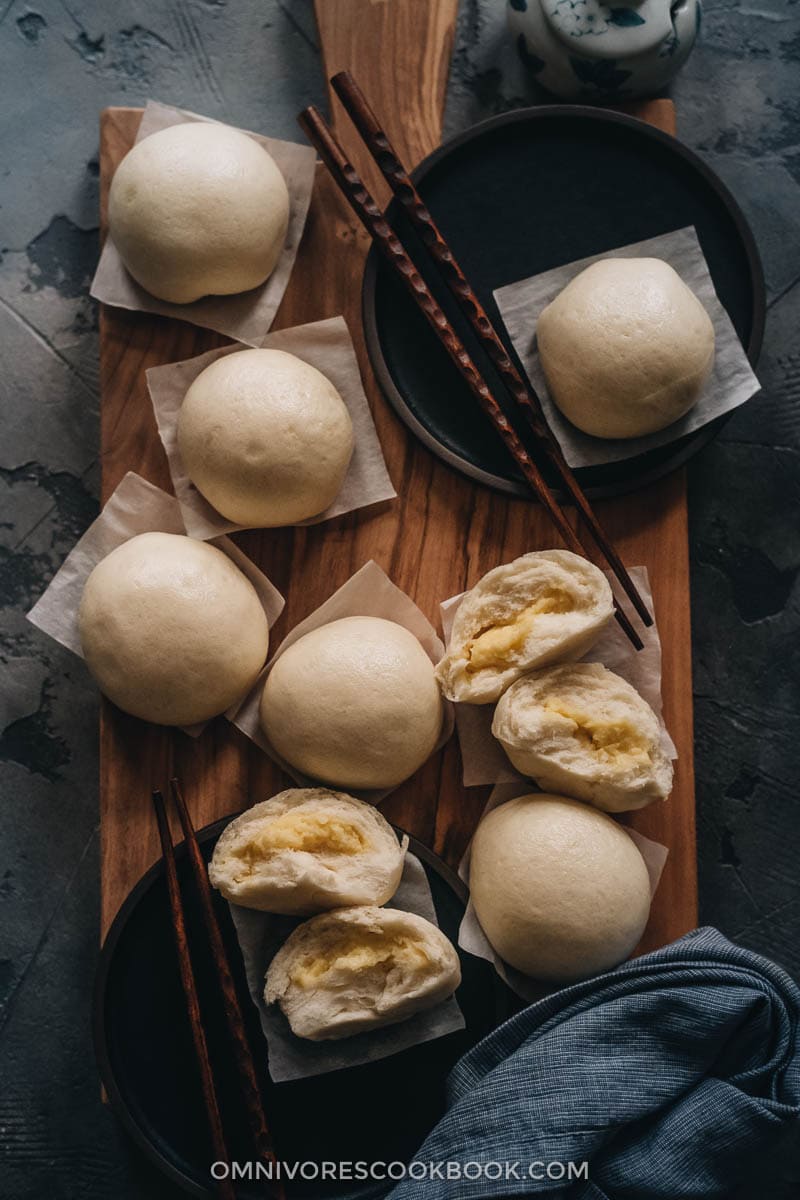
Why this recipe
There are many ways to make steamed custard buns. But to recreate the real-deal dim sum experience, you want a very soft bun with tiny air bubbles and a smooth surface. The filling should be creamy and fragrant. We tested the recipe using different methods and finally chose the one that has the fewest ingredients and the easiest process.
- The recipe uses very simple ingredients. You probably already have them in your pantry.
- The dough is super easy to put together using a kitchen mixer.
- The recipe produces the real-deal dim sum style steamed custard buns.
Cooking process
I know the recipe looks really long. Because I wanted to cover all the ground and make the cooking process well-documented with plenty of detail, to help you recreate this dim sum classic in your kitchen.
But in reality, the active prep and cooking time is quite short and easy. Here is how.
1. Prepare the dough – 1st rise
The recipe starts by activating the yeast. Once done, all you need to do is mix the liquid ingredients with the dry ingredients with a few stirs. Then you can let the mixer do all the heavy lifting.
Note, I added the shortening while mixing the dough. It helps the shortening work into the dough and creates a better texture.
If you do not want to use a mixer, it’s possible to knead the dough with your hands, especially if you have some bread making experience. You might need to knead the dough a bit longer to achieve a good result.
Rest the dough for 2 hours while you work on the filling.
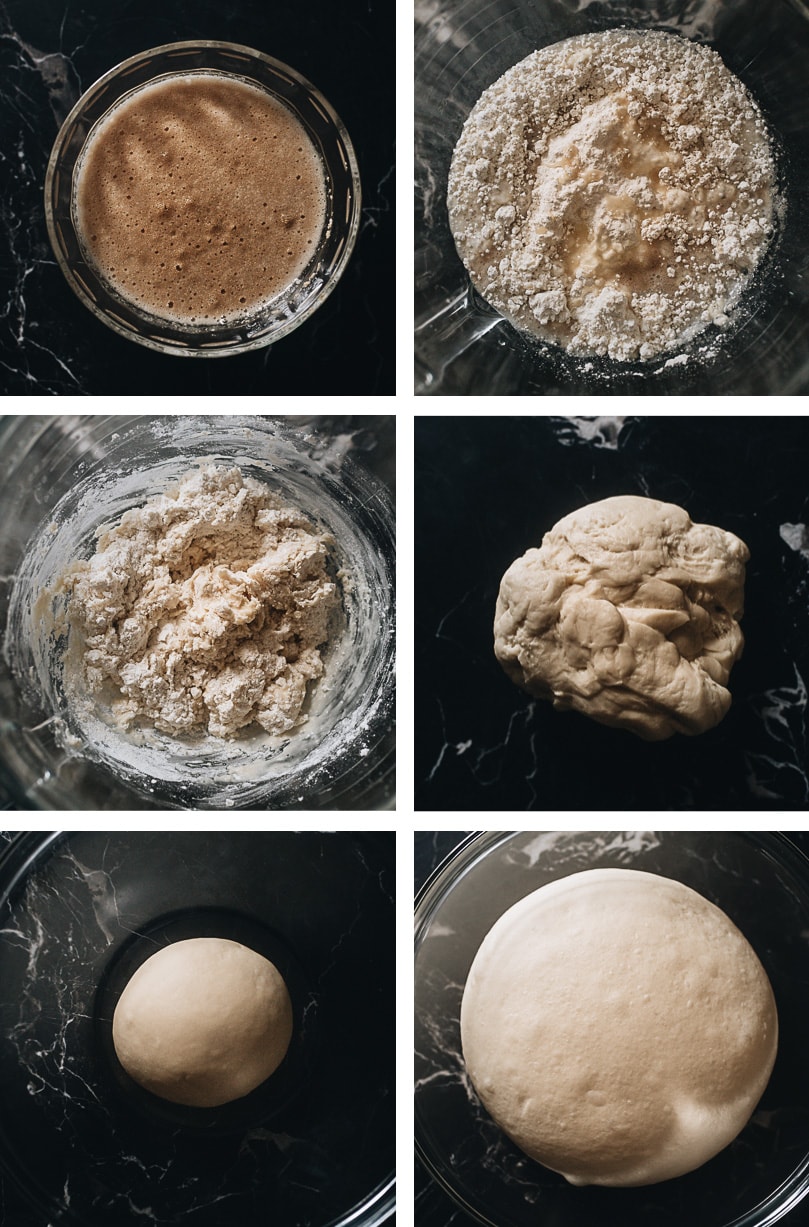
2. Egg quality matters
Because the recipe contains very few ingredients, it’s important to use high quality eggs in this recipe so it yields a fresh and fragrant result.
My favorite egg brand is Pete and Gerry’s Organic Eggs. They source fresh, high quality eggs from the small family farms they partner with, and then bring them to your grocery store. Unlike at mass-production facilities run by big corporations, their hens are truly humanely treated and have access to fresh water and grass. As a result, you’ll notice that their egg yolks have a beautiful vibrant yellow color, which holds up well when you separate the eggs and yields a much richer taste.
I used just a touch of vanilla and a modest amount of sugar in the recipe, so the egg flavor will come through.
I mentioned Pete and Gerry’s eggs in a previous post, if you want to learn more about the brand.
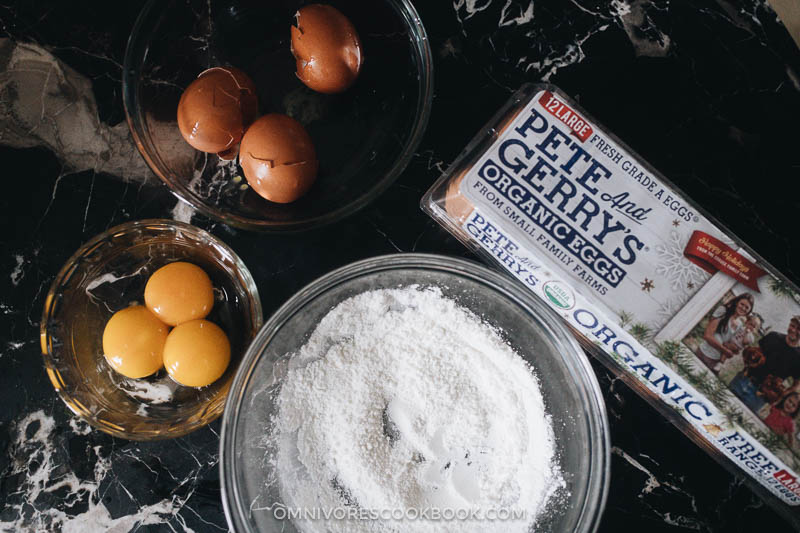
3. Prepare the custard
This recipe uses a standard custard recipe as the base. It contains more flour than regular custard so it is easy to form it into the custard filling.
The workflow is:
(1) Mix the dry ingredients
(2) Heat up the milk and half of the sugar until warm
(3) Mix the egg yolks with the dry ingredients
(4) Add the milk into the egg yolk and flour mixture

(5) Cook the mixture until it thickens
(6) Strain the custard for a smooth texture
(7) Chill the custard in the fridge
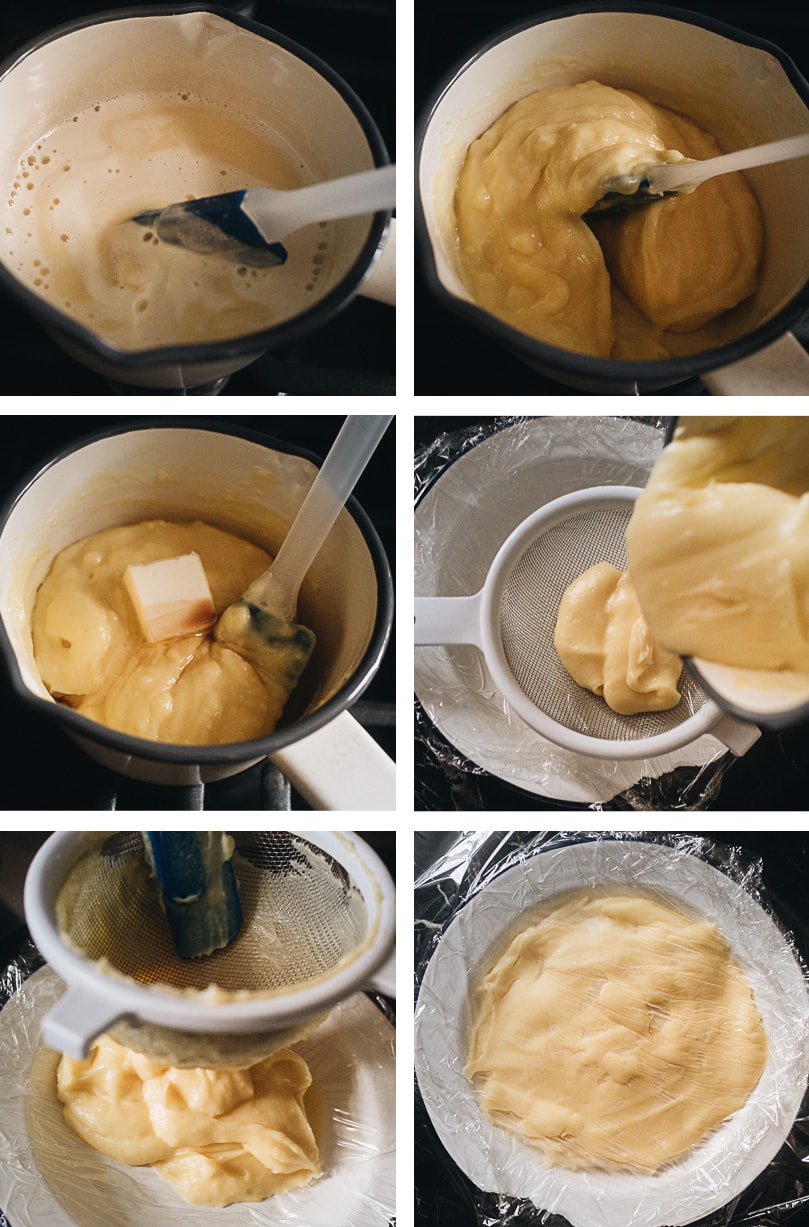
Note:
- Make sure you don’t overheat the milk, otherwise it will cook the eggs and make the filling into a lumpy soup. I usually use a thermometer to make sure the milk doesn’t get hotter than 150°F (65°C). If you do not have a thermometer, you should heat up the milk over low heat until it’s warmed up but not too hot if you put your finger into the milk.
- Do not mix the egg yolks with the dry ingredients before you heat up the milk. The sugar will cook the egg yolk and change its texture if added too early.
- Stir the custard constantly as you heat it up on the stove. The mixture will be very runny at the beginning and will take a few minutes to cook. But once it starts to thicken, it thickens very quickly, like flipping a switch.
- Chill the custard completely before forming the buns. The texture will harden and become easier to work with once cooled.
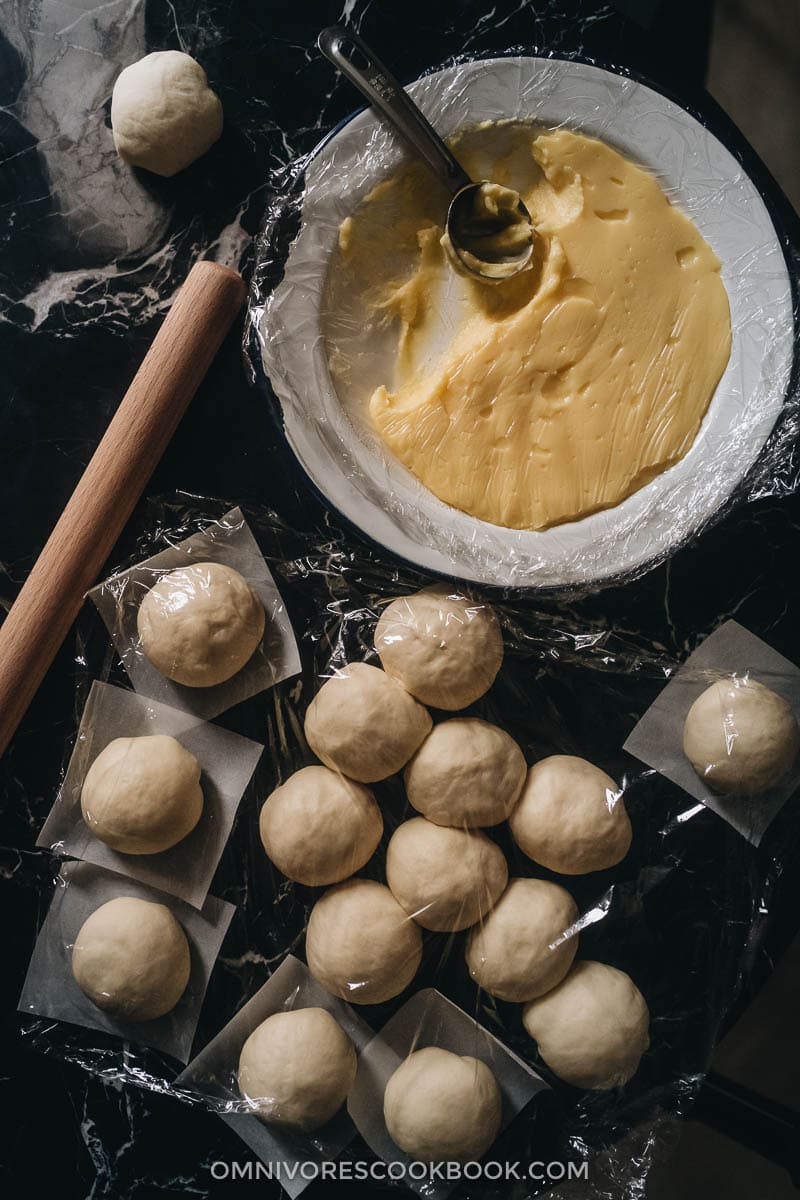
4. Wrapping the buns
The dough will triple in size once rested, as well as become smooth and soft. You’ll need to punch the dough to squeeze out the air, so the end result will have an even texture.
Divide the dough into 16 even pieces. To ensure even baking and consistent size, you can measure out the dough balls with a scale.

Roll the dough ball into a disk, with a thick center and thin edges. Because when you wrap the bun, it forms pleats. By rolling the edges thin, you will eventually get an even dough texture for the finished buns.
It’s quite easy to wrap the buns. Simply pinch the dough together to seal the bun, and place it upside down, so the top of the bun is smooth.
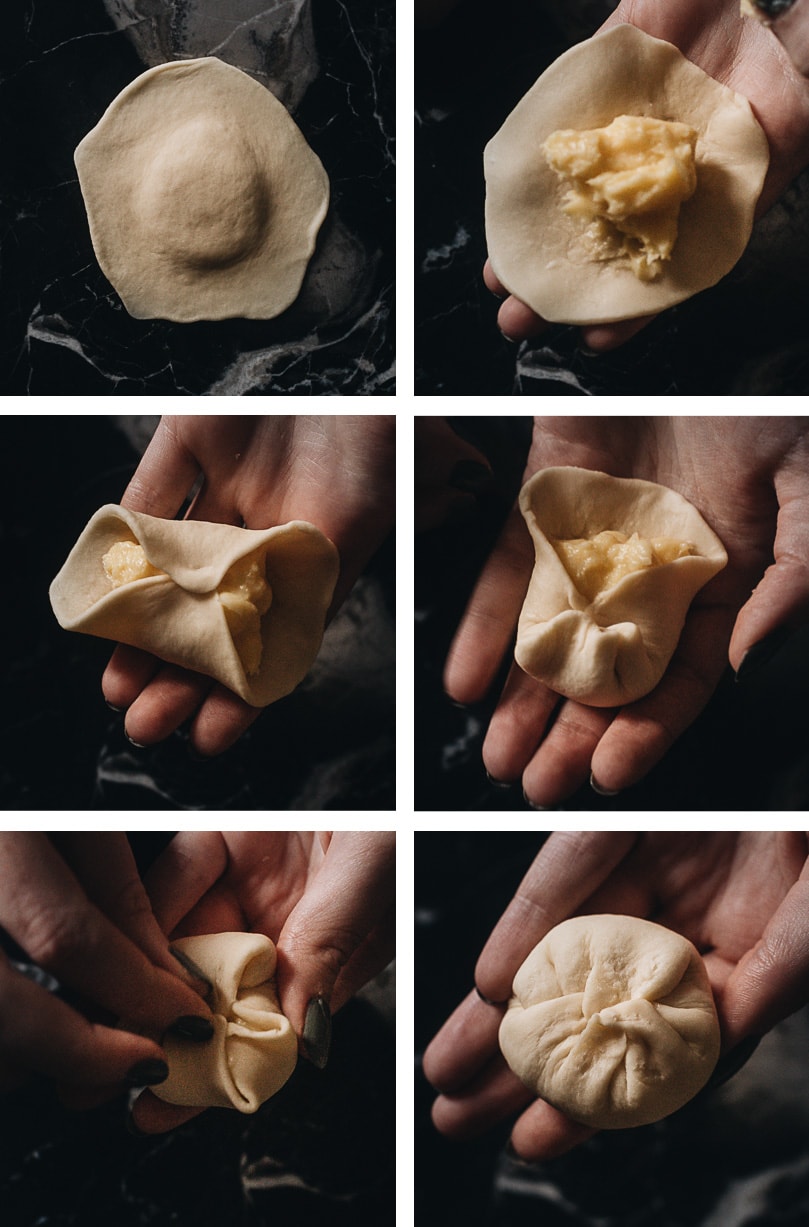
5. 2nd rise & steam
Once you wrap the buns, you’ll need to rest them for another 20 to 30 minutes, so they will rise again and create a fluffy texture.
What I recommend doing is to set a stopwatch (a timer works, too) once you finish wrapping the first bun. After 15 minutes, prepare the steamer so the first batch of buns is ready to go. It’s very likely that you’ll need to steam the buns in batches. With this setup, you can steam the first batch while wrapping the rest of the buns.
Steam the buns for 10 minutes. Once done, the buns will be soft and fluffy, just like the ones from a dim sum restaurant.
6. Serve & store
You can serve the buns when they’re just out of the steamer. But I usually rest the buns for 10 minutes before serving, so they are not burning hot. These buns are the best when they are hot or warm. But I found them absolutely delicious even when they have cooled to room temperature. The dough holds up well so they will stay soft once cooled.
If you don’t plan to serve the buns on the same day of cooking, you should wait until they have cooled completely, transfer them to an airtight container, and store them in the fridge. Try to serve them as soon as possible to get the freshest taste.
I do not recommend freezing these buns if you can help it. The custard filling will separate and become a bit watery. The mass-produced custard buns can be stored frozen because they usually contain additives to maintain the texture of the custard.
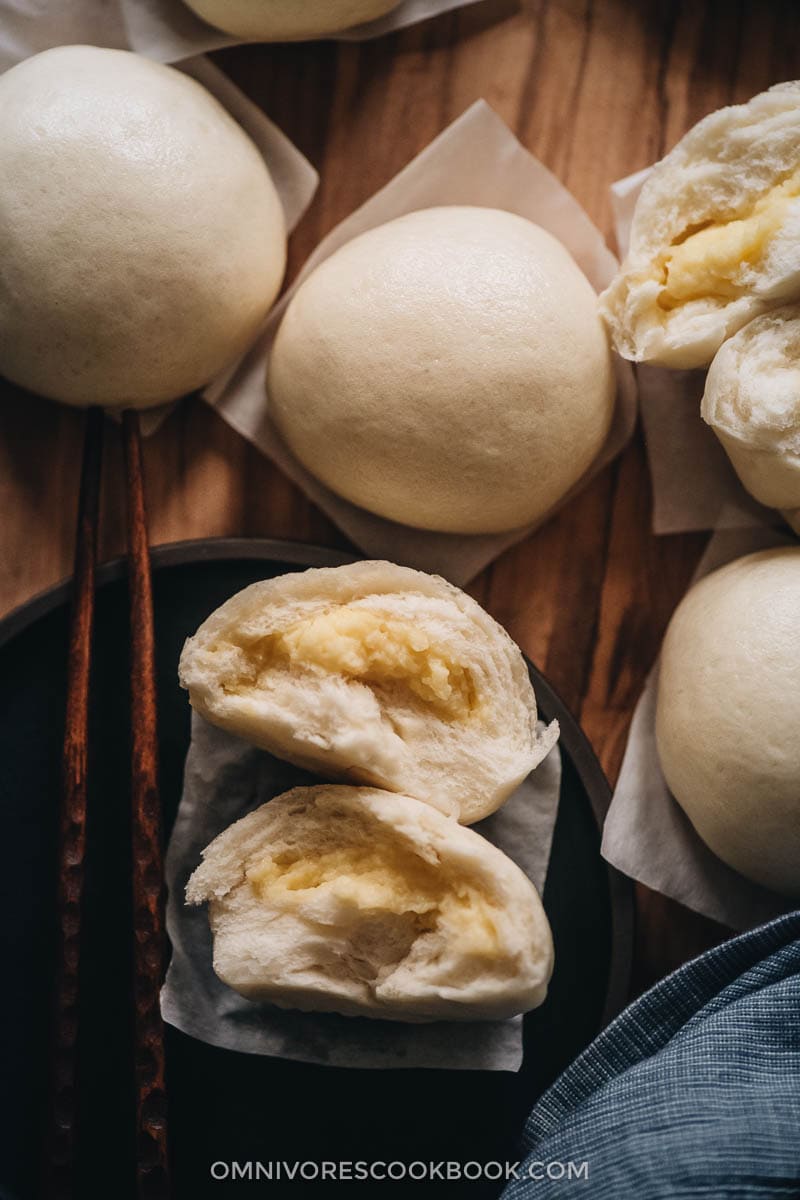
Afterthought
Dim sum making probably sounds daunting at first, but you’ll find the results extremely rewarding. Next time, no matter whether you’re hosting a dim sum party or simply want to have some fresh bread sitting there for your family to snack on, try out these steamed custard buns. I doubt you’ll ever worry about storing them because they’ll be gone in a second.
More delicious dim sum recipes
- Chinese Chive Pockets (Chinese Chive Dumplings)
- Char Siu (Chinese BBQ Pork)
- How to Make Chinese Egg Rolls
- Wonton Soup
- Authentic Chinese Scallion Pancakes
- Steamed Ribs in Black Bean Sauce
If you give this recipe a try, let us know! Leave a comment, rate it (once you’ve tried it), and take a picture and tag it @omnivorescookbook and @peteandgerrys on Instagram! I’d love to see what you come up with.
Chinese Cooking Made Easy
Are you new to this website? This free email series is a great place to start. I’ll walk you through a few of my most popular recipes and show you how and why they work. You’ll quickly start to cook better Chinese food in your own kitchen.
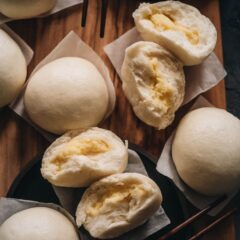
Chinese Steamed Custard Buns (nai wong bao, 奶黄包)
Ingredients
Dough
- 125 g (1/2 cup) water , warm
- 7 g (1 packet / 2 teaspoons) active dry yeast
- 60 g (4 tablespoons) sugar
- 250 g (1 2/3 cup) cake flour (or low gluten flour)
- 7 g (2 teaspoons) baking powder
- 7 g (1 1/2 teaspoons) shortening
Filling
- 20 grams (3 tablespoons) cornstarch
- 3 grams (1 teaspoon) all-purpose flour
- 56 grams (1/4 cup) granulated sugar , seperated
- 3 large Pete and Gerry’s Organic Eggs egg yolks
- 240 grams (1 cup) whole milk
- 15 grams (1 tablespoon) butter
- 1/4 teaspoon vanilla extract
Instructions
Prepare the dough
- Add the water into a small bowl and warm to approximately 100-110°F (38°C), about 30 seconds in the microwave. The water should be warm, just a bit above body temperature. Add the sugar and active dry yeast. Let sit for 5 minutes so the yeast will activate.
- While the yeast activates, add the cake flour and baking powder into your mixer bowl.
- Once the yeast is activated, you should see bubbles on the surface of the mixture. Pour it into the mixer bowl. Mix with a spatula a few times, until the liquid is just absorbed by the dry ingredients.
- Install the dough hook on your mixer. Start at low speed, then gradually increase to speed setting to 6 out of 10. Knead for 10 minutes, until the dough is very smooth. Stop the mixer in the middle and scrape the dough from the sides of the bowl.
- Add the shortening. Knead on level 6 for another 5 minutes. The dough should be soft, smooth, and easily lift from the bowl without sticking to your hands.
- Lightly grease a large bowl with butter or oil spray. Transfer the dough into the bowl. Cover the bowl with plastic wrap and let it rest in a warm part of your room, until the size triples, about 2 hours.
Prepare the custard
- Prepare the custard while the dough is resting. Mix the cornstarch, all-purpose flour, and half of the sugar together in a small bowl.
- Place the egg yolks in a large bowl. Stir a few times to mix the yolks.
- Add the milk and the remaining half of the sugar into a small saucepan. Heat over medium heat. Stir occasionally to dissolve the sugar completely. Cook until it reaches about 120 °F/ 49 °C (no more than 150 °F / 65 °C). You might see a few bubbles here and there. If the milk starts foaming, it’s too hot.
- While the milk starts to get warm, add the dry ingredients (from step 1 of the custard) into the bowl with the egg yolks. Whisk until it forms an even paste. Do not add the dry ingredients too early, because the sugar will change the texture of the eggs.
- Add the warm milk into the egg yolk mixture, about 1/4 cup at a time. Whisk constantly until the milk is fully incorporated into the paste. Continue to add more milk, a 1/4 cup at a time and continuously stirring, until it forms a thin, smooth mixture and all the milk is added.
- Return the mixture back to the pot (the one you used to heat the milk). Heat over medium low heat and stir constantly, until the mixture thickens, 5 minutes or so. Keep cooking and stirring, until you can draw a line on the bottom of the pot using a spatula. (Note, the custard will start to thicken suddenly, like a switch was flipped. So you should keep a close eye on it.)
- Remove the pot from the stove immediately. Add the butter and vanilla extract. Stir to mix well.
- Line a large, deep plate with plastic wrap. Place a large mesh strainer on top.
- Pour the custard into the lined plate through the strainer to smooth out the texture. Use a spatula to press the custard through the strainer if any lumps remain.
- Cover the custard with plastic wrap. Press the wrap against the custard, so it won’t form a skin once it’s chilled.
- Chill the custard in the fridge until it’s cooled, 2 hours or so. Or in the freezer for 30 mins.
Assemble
- Cut some parchment paper into 3” (7 cm) squares to hold the buns. You’ll need 16 squares.
- Punch the air out of the dough. Transfer it onto a lightly oiled working surface. Knead a few times to make the dough into a round ball. Divide the dough into 16 even pieces by cutting it into 2 even strips, then further cutting each strip into 4 small pieces. Each piece of dough should weigh 27 grams. Use your hands to roll and shape the dough pieces into dough balls.
- Wrap the buns one at a time.
- Flatten the dough ball using your palm. Use a rolling pin to roll a dough ball into a round disc that is thick in the middle and thin on the edges, about 2.5 to 3” (6 to 7 cm) in diameter. Carefully remove it from the surface and place it onto your palm.
- Place about a heaping tablespoon of custard onto the center of the wrapper. Press the custard into the dough to release any air bubbles within the custard. Use your other hand to gather the wrapper onto the top of the custard filling. The dough sheet will start to form pleats and retain its round shape.
- Once done, place the custard bun onto one of the cut parchment squares, pleated-side-down, then place it on a plate. Loosely cover it with plastic wrap to prevent them from drying out. Repeat the process to wrap the rest of the buns.
- Set a stopwatch (or timer) after wrapping the first bun, to keep track of the resting time. You need to rest the buns for 20 to 30 minutes before steaming.
Steaming
- Depending on the size of your steamer, you might need to steam the buns in batches. What I usually do is prepare the steamer after wrapping half of the buns, so some of them are ready to be cooked as you work on the rest.
- To prepare the steamer, add about 3” (7 cm) of water to the pot and heat over medium-high heat until the water starts to boil. Place the rested buns onto the steamer rack, leaving at least 2” (5 cm) in between, because the buns will expand a lot as they cook.
- Cover and let steam for 10 minutes. Once done, remove the steamer rack and place it onto a trivet. Uncover the steamer rack carefully. Let the steam out and then transfer the buns onto a serving plate. Let the buns cool for 5 minutes before eating.
- Cook the rest of the buns using the same method.
Serve and store
- The custard buns taste best when they are still warm, but you can serve them at room temperature, as well.
- Once the buns have cooled completely, place them in a sealed container at room temperature, if serving the same day.
- You can store the buns for 2 to 3 days in the fridge. To serve, heat up the buns until warm using the microwave.
Nutrition

Did you make this recipe?
I’d love to hear how it turned out for you! Please take a moment to leave a 5-star rating ⭐️ and share your thoughts in the comments further down the page. It really helps others discover the recipe too.

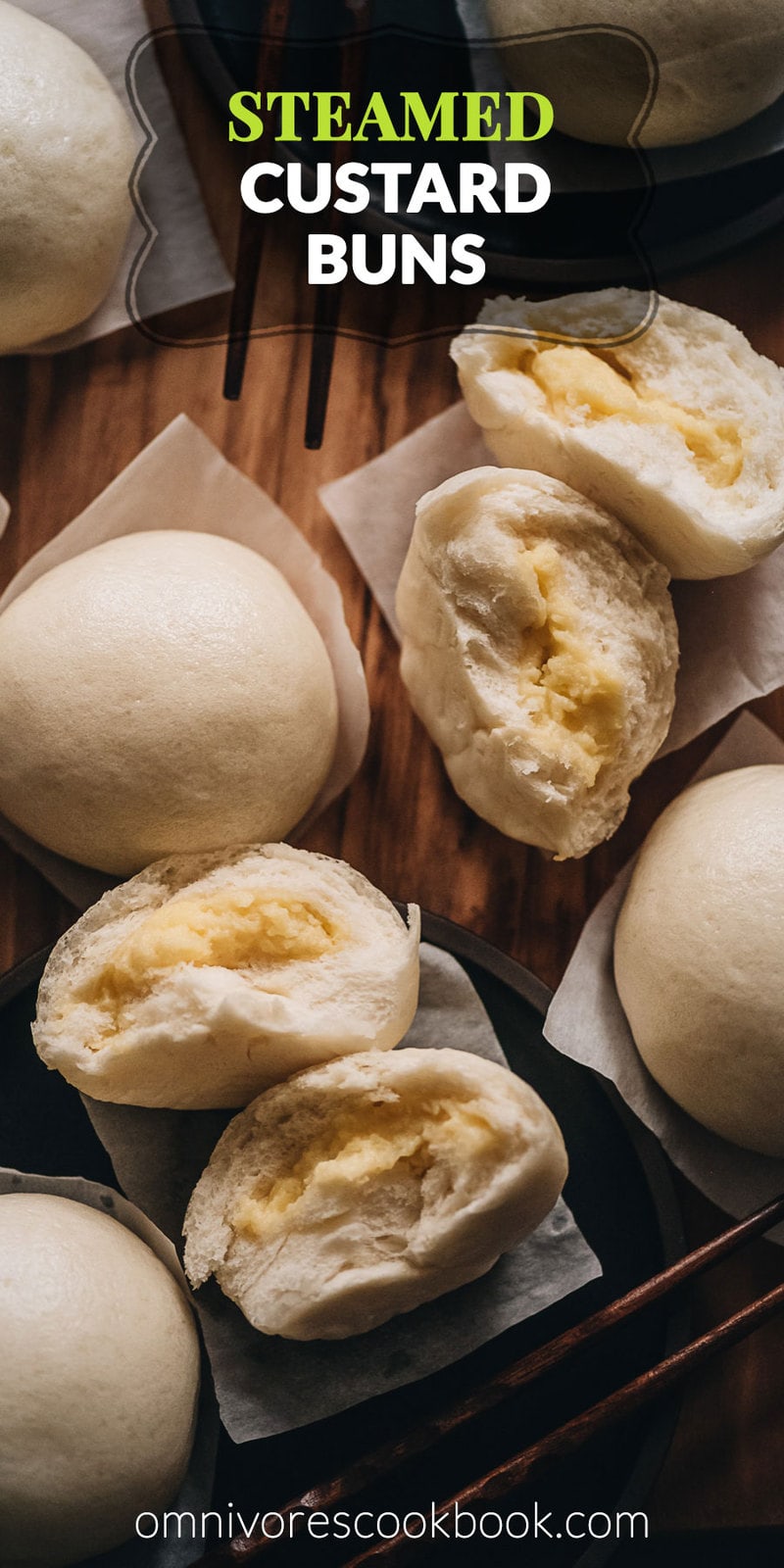
Olivia
Would it be possible for me to substitute the active dry yeast for instant dry yeast?
Maggie Zhu
You totally can. You should use a little less, 1 3/4 teaspoons of instant yeast as substitution.
Goob
It was super yummy thank you
Cindy
This recipe was absolutely perfect. The texture of the bun was exactly like I get at restaurants or bakeries. The custard was so warm and light too.
Jan
What is a steamer or how can I make something to work like one? Can you include a photo of a steamer? Thanks!
Maggie Zhu
This is the type of steamer I use: https://amzn.to/3q2rmX0 (mine is not AllClad and it has been discontinued)
Alternatively, you can also use bamboo steamers: http://amzn.to/2cudXGy If using them, you will need a pan that is large enough to hold the steamers, and deep enough so the water will not reach to the steamers when boiling (such as a large wok).
I usually recommend the first type because you can use the bottom pot separately as a soup pot.
Usually you can create a steamer by placing a dish on a rack inside of a pot. However, that approach is good for many savory food but might affect the bun rising.
Marla
The buns turned out so perfect!! Very authentic and yummy!
Paige
Really delicious and easy…I was always intimidated by custard before trying this recipe. I ran out of filling a little early and filled the last 2 buns with orange marmalade instead. Also used all purpose flour which was serviceable but will be trying with a lower gluten flour next time.
How might I modify the custard recipe to make a chocolate custard instead?
Yvonne
Hi Maggie! Thanks so much for sharing this recipe. Made it last weekend and loved it. I was thinking of trying the dough again just to get familiar with the process. Do you know any other fillings that would work with it?
Maggie Zhu
I’m glad to hear you like the recipe!
Yes! I think fillings like char siu, red bean paste and lotus seed will work.
You can find them here:
https://omnivorescookbook.com/char-siu
https://omnivorescookbook.com/recipes/how-to-make-red-bean-paste
https://omnivorescookbook.com/homemade-lotus-seed-paste/
Yvonne
Thanks so much! <3
Alice
Very nice. The custard was very creamy. Wasn’t hard to make.
Kai
This recipe is so easy to make and it is so delicious. Thank you so much for sharing your recipe. I would like to ask if I would like to make mántóu, would you use this recipe for the dough?
Maggie Zhu
Glad to hear you like the recipe!
I wouldn’t use the dough for Mantou because it doesn’t have filling and needs a more structured dough. Actually I’ve been testing mantou dough for a while and it’s very finicky. It’s better to use instant yeast than the dry active yeast. Anyhow, hopefully I’ll have a recipe soon.
Nikki Jackson
These were amazing! They are so easy to make! We filled some of ours with Kaya jam instead of custard and they were so good! I will definitely be making these again!
Cassie M
I’m definitely going to try that! I love Kaya jam but it’s impossible to find in the states so I guess I’ll have to make some.
Sophie
So delicious and easy to make!!!
ferah
I’m going to give this a shot. What steamer do you use? Do I need a specific one?
Maggie
I use a large stainless steel steamer and it worked well. You can also use a bamboo steamer if you have one. You don’t need a specific steamer to make this recipe as long as the buns will fit in the steamer rack (and you can always steam in batches).
Ella
I made the custard filling to put inside your pineapple bao recipe. I always have issues making custard. The stirring/thickening step definitely took way longer than 5 minutes. And I was only able to fill 10 out of 16 baos using a tablespoon. When baked, I wished the baos had more filling. Can you offer some tips in the custard making step? Thank you! The baos were delicious!
Maggie
I think you might have cooked the custard a big longer than I did, which make is less in volume. Although the custard will be much easier to work with if you thicken it a bit more. The steamed buns are smaller than the pineapple bun, so you can double the custard next time and fill in more custard.
I’ll keep this in mind and try to make a video on this so it shows more details on making the custard. Thanks for your feedback! 🙂
Marité
Perfect recipe. Tried it yesterday with butter (I am in France!). I substituted vanilla extract with sugar flavored with vanilla. There are still good heaten in microwave. This is my 2nd attempt doing bao dough (first was salted version). The 1st recipe said the fluffiness is kept by leaving the bao in the steamer during 5 min. I found it was true, because I didn’t do it with your recipe and they Were not so fluffy anymore …any guess?
Elisa
Just made this and its delicious! Going to try to make the char Siu Bao next 🙂
Alisa
Hi Maggie,
I’m in the process of making this recipe, but found the measurements a bit confusing. 1 and 2/3 cups of cake flour is way less than 250g of cake flour. Like a lot less. If I google cake flour cups to grams, it ranges from 1 cup = 100, 113, or 120 grams. I followed the cup measurement, but my dough did not hook to my dough hook and my dough was super sticky. I added tablespoons of cake flour at a time to help with the stickiness, but I know something went wrong. It’s in the proofing stage, but I don’t think it will rise. I wonder if I measured in grams that everything would’ve worked out. Can you please advise? Thank you!
viv
Hi – Thanks for all your delicious recipes. I came across this want was thinking of making, but I don’t have shortening at home. Is it OK to use butter instead or do you think I should just wait until I can find shortening?
Thanks,
Maggie
Softened butter will work fine. The texture and flavor will be slightly altered but the dough will function the same and the results will still be good! The important thing is that the butter is fully softened at room temperature before using.
Bakers Dozen
Hi Maggie, I tried making this recipe and found the dough a little “cake-like” and would break off, is this the texture? Also, they turned out alright but none of the fluffy-ness, almost like a pancake ha. Do you have any tips? I used some Chinese wheat flour.. do you recommend using normal flour instead??
Maggie
It sounds like a problem with the yeast or gluten development. If the dough came out like a pancake, maybe the yeast wasn’t properly activated. It’s possible that the yeast was dead, got killed by hot water or because of the environment that the yeast was too warm/cold and over/under proofed. It’s also possible that the dough was extremely over kneaded but that would take a fair bit of effort. Chinese wheat flour should be fine to use. It’s not that a big different from regular flour and shouldn’t cause dramatic effect on the result.
Thai
Amazing recipe and I highly recommend! These came out perfect. I just need to work on evening out the bun, but the taste is on point.
Mil Hare
These look completely delicious – I’ve been wanting to try my hand at dim sum and maybe this is a place to start..